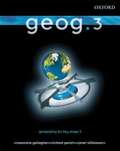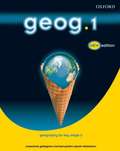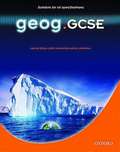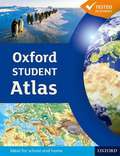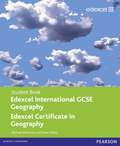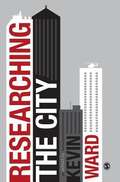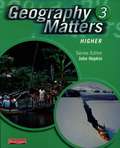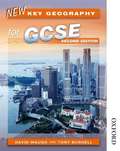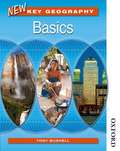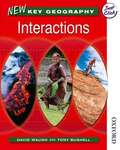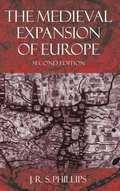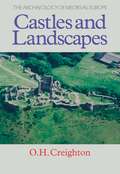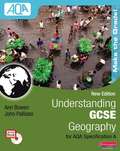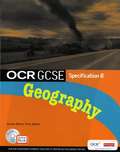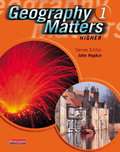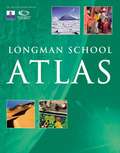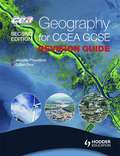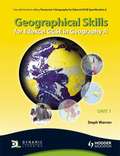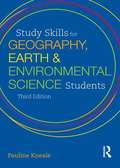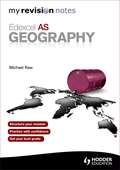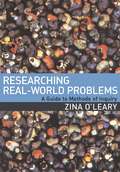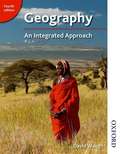- Table View
- List View
Geog. 3: Student Book (1st edition)
by Rosemarie Gallagher Janet Williamson Richard ParishGeog.3 is the third book in the three-book Geog.123 course written to match the National Curriculum at Key Stage 3 and the QCA Scheme of Work. It also provides excellent support for the Foundation Subjects strand of the National Strategy (FS/TLF), including starters and plenaries, levelled assessments, and help with implementing assessment for learning. Many teachers have said that Geog.123 is the best course available. It is comprehensive and rigorous, but what really sets it apart is that it's written and presented in a way that appeals to students in the 11-14 age group like no other course.
Geog. 1: Student Book (2nd edition) (PDF)
by Rosemarie Gallagher Janet Williamson Richard ParishGeog.1 is the first book in the three-book Geog.123 course written to match the National Curriculum at Key Stage 3 and the QCA Scheme of Work. It also provides excellent support for the Foundation Subjects strand of the National Strategy (FS/TLF), including starters and plenaries, levelled assessments, and help with implementing assessment for learning. The second editions of the students' books have been fully updated, and include particularly good coverage of topics such as Football (geog.1), Crime in the local community (geog.2), and the global fashion industry (geog.3). Many teachers have said that Geog.123 is the best course available. It is comprehensive and rigorous, but what really sets it apart is that it's written and presented in a way that appeals to students in the 11-14 age group like no other course.
Geog. GCSE: student book (PDF)
by John Edwards Chris Stevens Jack Mayhew Anna King Catherine HurtAn engaging students' book for GCSE Geography (14-16 years), providing up-to-date content and case studies. The course provides excellent support for the Secondary Strategy, including starters and plenaries and help with implementing assessment for learning. It is comprehensive and rigorous, and is written and presented in a way that appeals to students. Tectonic activity Rocks and landscapes Glacial landscapes River landscapes Coastal landscapes Weather and climate Ecosystems Population Settlement Agriculture Industry Managing resources Development
Oxford Student Atlas (4th edition) (PDF)
by Patrick WiegandThis new edition of the Oxford Student Atlas includes stunning satellite images, country data, and easy-to-read colourful mapping, presented in an accessible visual layout based on research into how students use maps. The atlas covers key exam specification themes and issues such as earthquakes and volcanoes, climate and climate change, economic activity, development, and globalisation. It includes comprehensive coverage of the British Isles, Europe, and the world. It is the ideal atlas for students to use on exam courses.nbsp;
Population & Development (PDF)
by W GouldPopulation and Development addresses important issues at the heart of the problems of developing countries. How these countries address the common difficulties of population growth, including mortality and fertility decline, population redistribution including internal migration and urbanization, and also international migration, for both source countries and for destination countries. How and why has population change affected development - both positively and negatively? How and why has development affected population change - both growth and distribution?nbsp;
Edexcel IGCSE Geography (Student Book) (2nd edition) (PDF)
by Michael Witherick Steve MilnerWritten by examiners to be accessible for every student with an attractive, full-colour design. All statistics and case studies use current up-to-date information and are taken from a wide variety of international contexts. The free ActiveBook CD contains Geography animations, PowerPoint presentations, a range of revision resources, fieldwork opportunities and past exam questions. Full answers to the Student Book questions are available to teachers and parents by emailing customersolutions@pearson.com (for UK teachers and parents) or icsorders@pearson.com (for all other teachers and parents). Author Biographies Michael Witherick has written a wide range of A-level and GCSE Geography texts for several publishers. He has over 20 years' Chief Examiner experience, was involved in the design of Edexcel's current International GCSE Geography specification and is currently serving as the subject's Senior Reviser. He formerly lectured in Geography at the University of Southampton. Steve Milner has been a Geography Chief Examiner since 1979 and has been the Edexcel International GCSE Geography Chief Examiner since 2005. He is the Chief Examiner for the new 2009 Geography specification. Steve has written a number of GCSE textbooks, including the Longman textbook for the previous Edexcel International GCSE Geography specification. Over a 40-year career in Geography, he has been a school and college Head of Department, an advisory teacher and a university tutor, and continues to teach part-time in a school.
Researching the City: a Guide for Students (PDF)
by Kevin WardThis practical guide for students focuses on the city and on the different ways to research it. The author explains how research is done, from the original idea to design and implementation, through to writing up and representation.
Geography Matters 3: Higher (PDF)
by Lisa Owen Sue Lomas Paul Thompson Garrett Nagle Nicola Arber Roger Sanders Linda Thompson Rob BowdenGeography Matters is a Key Stage 3 course created for pupils of all abilities. The pupil textbooks for year nine are parallel in their content coverage but are set at different levels, Foundation and Higher, to provide material at the right level and pace for both less able and more able pupils. Pupil books emphasize investigation skills, and integrated geographical skills such as map work and data analysis. The activities are linked to literacy and numeracy and have integrated ICT skills. Regular tasks provide feedback on progress and extention activities.
New Key Geography for GCSE, pupil book (2nd edition) (PDF)
by David Waugh Tony BushellWritten by experts in the field of geography this work has been fully revised and updated to meet all the new GCSE specifications as well as Standard Grade.
New Key Geography: Basics, pupil book (New edition) (PDF)
by Tony BushellDesigned to meet the needs of lower-ability pupils, this text book has been revised and expanded to cover all topics of the New Key Geography pupil books. This full-colour textbook is closely linked to the core New Key Geography pupil books and covers all topics in an easy, accessible way. Contains simple language with more space and bigger font to help lower ability pupils to absorb information. Clear diagrams aid visual learning.
New Key Geography: Interactions, pupil book (4th edition) (PDF)
by David Waugh Tony BushellDevelop your pupils' key geographical skills with this series of full-colour textbooks containing up-to-date case studies, large scale maps and integrated OS work. Topics such as sport, fashion, internet shopping and leisure makes learning releva Introductory resources stimulate discussion and encourage the development of pupils' geographical and thinking skills. Independent research and decision making work develops key skills.
The Medieval Expansion of Europe (2nd edition) (PDF)
by Phillips, John Roland SeymourBetween the year 1000 and the middle of the fourteenth century a remarkable series of events unfolded as Europeans made contact with a very substantial part of the inhabited world, much of it never previously known to or suspected by them. Leif Ericsson and other Vikings from Greenland discovered North America; European crusading armies established themselves in Syria and Palestine; Marco Polo and other Italian merchants, and missionaries such as John of Monte Corvino penetrated the dominions of the Mongol great Khans as far as China; the Vivaldi brothers sought to open a sea route to India; Jaime Ferrer was lured by dreams of locating the source of West African gold; and the Atlantic island groups, the canaries, Madeira, and the Azores, were all discovered. For this Clarendon Paperback edition, Professor Phillips has added a new Foreword and Conclusion, as well as a bibliographical essay, surveying recent work in what is becoming a thriving area of research.
The Medieval Expansion of Europe (2nd edition) (PDF)
by Phillips, John Roland SeymourBetween the year 1000 and the middle of the fourteenth century a remarkable series of events unfolded as Europeans made contact with a very substantial part of the inhabited world, much of it never previously known to or suspected by them. Leif Ericsson and other Vikings from Greenland discovered North America; European crusading armies established themselves in Syria and Palestine; Marco Polo and other Italian merchants, and missionaries such as John of Monte Corvino penetrated the dominions of the Mongol great Khans as far as China; the Vivaldi brothers sought to open a sea route to India; Jaime Ferrer was lured by dreams of locating the source of West African gold; and the Atlantic island groups, the canaries, Madeira, and the Azores, were all discovered. For this Clarendon Paperback edition, Professor Phillips has added a new Foreword and Conclusion, as well as a bibliographical essay, surveying recent work in what is becoming a thriving area of research.
The Archaeology of Medieval Europe: Castles and Landscapes
by O. H. CreightonCastles were among the most dominant features of the medieval landscape, and many remain impressive structures to the present day. This work looks at castles in a new light, using the theories and methods of landscape studies. Castles are examined not as an isolated phenomenon, but in relation to their surrounding human as well as physical areas. Taking a thematic approach, the study examines a broad range of evidence, archaeological, documentary and topographical, to assess the contribution of these structures on the evolution of the medieval landscape. The imprint of castles on the human landscape was powerful and often long-lived. As imposing icons of status and lordship, castles re-shaped the landscape in the minds of contemporaries, while as estate centres and manors they were closely connected with their surrounding hinterlands. The settlement landscape was also deeply affected by castle building as their powerful aristocratic owners fostered new towns and villages, while other communities were disrupted by their construction. The types of sites chosen for castles are also examined, as are the features that often accompanied them, including churches, mills, monasteries, deer parks, fishponds and gardens. Throughout, this book challenges many of our perceptions about medieval castles and presents some new avenues for future research. Alternative ISBNs 9781904768678
The Archaeology of Medieval Europe: Castles and Landscapes (PDF)
by O. H. CreightonCastles were among the most dominant features of the medieval landscape, and many remain impressive structures to the present day. This work looks at castles in a new light, using the theories and methods of landscape studies. Castles are examined not as an isolated phenomenon, but in relation to their surrounding human as well as physical areas. Taking a thematic approach, the study examines a broad range of evidence, archaeological, documentary and topographical, to assess the contribution of these structures on the evolution of the medieval landscape. The imprint of castles on the human landscape was powerful and often long-lived. As imposing icons of status and lordship, castles re-shaped the landscape in the minds of contemporaries, while as estate centres and manors they were closely connected with their surrounding hinterlands. The settlement landscape was also deeply affected by castle building as their powerful aristocratic owners fostered new towns and villages, while other communities were disrupted by their construction. The types of sites chosen for castles are also examined, as are the features that often accompanied them, including churches, mills, monasteries, deer parks, fishponds and gardens. Throughout, this book challenges many of our perceptions about medieval castles and presents some new avenues for future research. Alternative ISBN 9781904768678
Understanding GCSE Geography for AQA specification A (Student Book) (PDF)
by Ann Bowen John PallisterFocused exam preparation to get the grades you want! Featuring an array of engaging and thought-provoking activities, this Student Book equips students with the core skills and understanding they need to reach their full potential at GCSE. Exciting, engaging activities help students develop a broad range of skills and consolidate understanding, and updated case studies put learning into a real-world context. Grade Studio activities provide practice exam-style questions, model answers and examiners comments and advice to help students understand what to do to get the right grade.
OCR GCSE Geography B: Student Book (PDF)
by Tom MillerThis book is endorsed by OCR for use with the OCR GCSE Geography B specification. Decision Making activities enable students to develop their decision-making skills, and personalised, enquiry-based resources encourage learning by discovery and the development of key geographical skills. Case studies and topical content make students think about how geography affects the real world. Exam Cafe and Grade Studio are featured, providing structured help from start to finish to build skills and prepare students for their exams. Also included is a free ActiveBook CD-ROM with every textbook, featuring an interactive Student Book, Exam Cafe and Grade Studio for complete support.
Geography Matters 1: Higher (PDF)
by Nicola Arber Linda Thompson Sue Lomas Garrett Nagle Paul ThompsonGeography Matters is a Key Stage 3 course created for pupils of all abilities. It provides an exact match to the requirement of the revised National Curriculum, and to the units of the Key Stage 3 Scheme of Work. Contents include: Making connections Restless Earth People everywhere Flood disaster Exploring England World sport
Longman School Atlas (PDF)
by Stephen ScoffhamLongman School Atlas Introduces key themes of interdependence, environment, globalisation, change and development including a chapter dedicated to development issues. Earth from the sky sections provide satellite images and aerial photographs for every continent, giving pupils the opportunity to use a variety of secondary sources. A map skills section gives clear guidance on how to use the atlas.
Geography for CCEA GCSE: Revision guide (PDF)
by Jennifer Proudfoot Gillian ReaAim for your best grade in Geography for CCEA GCSE with expert guidance for exam success. Endorsed by CCEA and written by experienced examiners and teachers, this revision guide has been designed to thoroughly prepare students for the CCEA GCSE Geography examination. Helps you to revise the essential information you need to know for the exam with summaries of the key content Helps you to consolidate key concepts and developments with activities and revision methods Improves your exam skills with practice questions, sample answers and examiner's advice
Geographical Skills for Edexcel GCSE in Geography A (Unit 1) (PDF)
by Steph WarrenGives students the skills they need for exam success in the compulsory component of Unit 1. Helps students to cover all the geographical skills - cartographic, graphical, ICT and GIS skills including OS map work at 1:50000 - and shows you how to use and apply them.
Study Skills for Geography, Earth and Environmental Science Students (3rd edition) (PDF)
by Pauline Estner KnealeThere are moments in everyone's degree when you are expected to do something unfamiliar and daunting - present a seminar, go on a fieldtrip, create a wiki page, lead a lab team - and how to do it or what to expect is unclear. Studying at university requires a different approach from studying at school and this book explains this transition. Packed with practical hints, study tips, short cuts, real-life examples and careers advice, this book will prove invaluable throughout your geography, earth science or environmental science degree. Designed for all geography, earth science and environmental science students, this book provides guidance on: time management and effective research constructing essays and creating arguments giving presentations confidently undertaking fieldwork and laboratory work avoiding plagiarism and citing references correctly using e-technologies such as blogs and your university's VLE online assessment and peer feedback. This guide also explains the role of the academic and how it differs from that of a school teacher, and prepares you for the world of work by showing how the skills you learn at university today can be used in your career choice of tomorrow.
Edexcel AS Geography (PDF)
by Michael RawMy Revision Notes for Edexcel AS Geography is designed to help take control of revision Topices covered include: The world at risk Extreme weather Crowded coasts Unequal spaces Re-branding places nbsp;
Researching Real-World Problems: a Guide to Methods of Inquiry (PDF)
by Zina O'LearyThis is the perfect book for any student new to Research Methods. It is brilliantly written, witty, and always easy to understand. Taking as her starting point the need for students to conduct research for themselves in the 'real world', Zina O'Leary guides those new to research through the whys and how-tos of the entire research process. Always student-focused, this book offers a hands on and practical guide to the research process from the initial process of coming up with a good question, via methods of gathering information, through to the writing process itself. Researching Real-World Problems :nbsp; Makes the entire research process a meaningful experience Provides a jargon-busting hands-on guide to the entire research processnbsp; Is illustrated throughout with real-life examplesnbsp; Speaks directly to the needs of the new researcher nbsp; Locates the researcher and research process at heart of a complex web of social structures nbsp; Provides via the Companion Website link above, PowerPoint slides that cover all 12 chapters of the book. They can be printed out as separate transparencies or used in PowerPoint based lectures. They would also be suitable for applications in e-learning// web-based teaching. O'Leary draws her examples from the full range of the Social Sciences, and this is the perfect text for any student in Health, Education or Applied Social Science.
Geography - An Integrated Approach (Fourth Edition): Student Book (PDF)
by David WaughA new edition of David Waugh's popular A level Geography text, offering comprehensive, global and in-depth coverage. Stimulate students with clear, in-depth material suitable for all A Level specifications and is also suitable for the Scottish Higher/Advanced Higher and international specifications. Content revised and updated throughout to reflect latest events, theories, concepts and terminology, with new case and place studies. Completely revised questions, written by AS and A level examiners for thorough examination practice.
